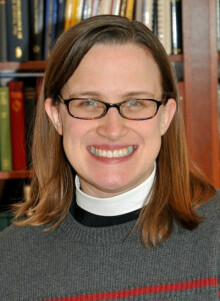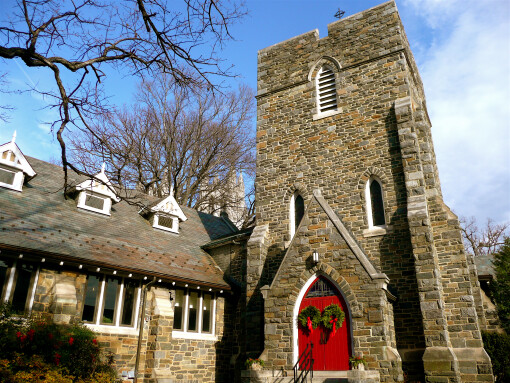What Are We Waiting For?

Series: Advent
Speaker: The Rev'd Emily Griffin
What are we waiting for? As of today, we’re officially in the season of Advent – the church-sanctioned season of waiting and preparation. Over a thousand years ago, the church set aside these four weeks before Christmas as a time to prepare – for what exactly? If we’re merely waiting for the baby to be born, that happened already. Trust me, there’s no surprise plot twist this year; our Christmas pageant isn’t going to end with a cliffhanger. We know how that story turns out. So if that’s not really what we’re waiting for, then what? Some say we need this time to remember why we needed Jesus in the first place. We read prophets like Isaiah so that we can appreciate the hopes Jesus fulfilled simply by being born. If the Word of God can become flesh, if the Almighty can show up alive and breathing and show us how to live honorably in real time, then maybe the angels’ song of “peace on earth, good will to all people” is actually possible.
We may call Jesus the Prince of Peace, but let’s face it - his arrival did not make us beat our swords into ploughshares. Our spears have not become farm tools. Despite Isaiah’s beautiful vision, the military industrial complex has not been subsumed by the Department of Agriculture. I long for the day when we won’t learn war any more, but even a child knows that day hasn’t happened yet. We can barely manage peace on our Facebook pages and Thanksgiving tables, much less on the world stage.
Perhaps Advent is a time, among other things, to remember what we’re still waiting for – and what we can do while we wait. I love this season, this celebration of light in the darkness, because it gives us a language for our longing, a vocabulary that’s stronger than sentiment or the pop slogans of the day. We need a force stronger than a tweet to carry us. We need a vision worth living toward, whose goal is broader and deeper than self-preservation or our nation first. We need to know that now is not as good as it gets, that tomorrow can be better than yesterday, and that we can have a role in making that happen.
Personally, I take comfort that these words from Isaiah were written over 2700 years ago. They remind me that my desire for a more peaceful, life-giving world has deeper roots than what my family would call my naïve idealism. That I am not an island left to make meaning all on my own; no, we stand in a deep, wide stream of dreamers and visionaries that’s so much bigger than we are - one that will carry us farther than our own steam or wisdom could ever take us.
I should ‘fess up and say that we’re not sure if Isaiah originated these words or if he borrowed them from his contemporary Micah. We don’t who put them to paper first. Both were prophets in the same era, and both use these images. But while Micah goes in one direction – Isaiah takes another. Micah personalizes the promise, adding: “but they shall all sit under their own vines and under their own fig trees, and no one shall make them afraid; for the mouth of the LORD of hosts has spoken.” As a preacher, I understand why he goes that way; his images are emotionally satisfying in a way that Isaiah’s ending just isn’t. Of course, we want to know that we personally will be secure someday, that we won’t have reason to be afraid anymore. Isaiah, though, ends not with a promise or a personal reassurance but with a collective call to action: “O house of Jacob, come, let us walk in the light of the LORD!”
How exactly do we do that? It’s a dark world out there, and for all the progress we’ve made these last two millennia, it doesn’t seem to be getting much lighter. It’s a lot easier these days for some of us to stay asleep, to sit on the sidelines in cynicism or despair than to find the energy to regroup and move forward. Given the bitter divisiveness in our nation and the tribalism brewing worldwide, how do we realistically walk together across party lines, across each other’s pain and betrayal, toward peace?
In Isaiah’s vision anyway, it begins with a willingness to accept instruction, the humbling admission that we’ve lost our way and need a new path forward. That in itself doesn’t seem so hard. A look at any day’s headlines would verify that. Don’t worry - we’re not relinquishing our claims to justice; we’re simply acknowledging that there are limits to what we can know. We’re admitting that the truth, whatever it is, is bigger than anything we can see from our limited perspective. We’re accepting that we, in fact, might have something to learn from God, perhaps even from each other. It’s not justice or peace just yet, but it’s a good first step.
OK, then what next? Well, for Isaiah anyway, some movement is involved. We can’t get to justice or peace sitting under the security of our own vines or fig trees. We need to move toward some common ground first. He envisions the nations of the earth gathering in Jerusalem. Some understandably might question the practicality of this, wondering how the God of Jacob could ever play fair – but perhaps that’s Isaiah’s point. That his God isn’t just the God of Jacob but of all the nations, and that we’ll all forever be limited in our vision if we think that God is on our side and ours alone. Isaiah asks his people to consider that other nations, other parties (i.e. whatever faction or nation or family member we’re fighting with these days) might, in fact, have just claims. It’s not just those “others” who need instruction, who need to learn new ways, he says. We all need to accept guidance from God and learn to walk in new paths.
Once we allow God the right to decide what’s just and relinquish our own need to be right at all costs, then it becomes easier to take the next step – namely, laying down our swords and spears. Note that God doesn’t magically take them away from us once we realize we don’t need them anymore; we actively need to lay them down before we can turn them into anything useful. It may take some time before we’re ready to trust and make that final turn. But for Isaiah anyway, it is possible to take those weapons and turn them into tools – into shared activities that feed people and bring hope and nourish life. We can find a new way forward together.
What does this look like in real life? Let’s start with a small example. I’m not the only one here with friends or family members whose political opinions are on the opposite end of the spectrum, whose social media posts over the last year and a half you’ve tried in vain to ignore, whose definition of justice will never match your own. I have one uncle in particular who fits that description. I love him but frankly I recoil at his politics, and I know he shudders at mine.
Anyway, over the last few weeks, as I’ve struggled with pneumonia, I’ve had to face some unpleasant, seemingly unrelated truths of my own. I’m not as strong as I think I am. I can’t be the perfect priest or the perfect wife, and I only get sicker when I try. I’ve let my own need to please people overcome my need for rest, and I’ve gotten stuck in a spiral I can’t fight my way out of on my own. It was in the depths of this embarrassing self-realization that I heard from my uncle, on Facebook of all places. He didn’t say a word to me about my politics or try to argue me to his side. He told me instead about his own struggles with pneumonia and how hard it was for him to rest too. He told me he loved me. I didn’t have to fight to find common ground with him; he found it first and met me there. In this case, it was easy to lay down my weapons. He’d already laid down his. We’re never going to agree politically, but I’m done making gross overgeneralizations about him and the people who voted like he did. What do I know? We can still find a way to be family for each other and walk together.
It may seem like a trivial example, but these are the places where peace starts – in email exchanges, across pews, at Thanksgiving tables. The reason we’re asked to “keep awake” –particularly in Advent - is so we can notice these small moments when they happen and let them mean something. These brief flickers of light won’t dispel all the darkness, God knows, but they do make it easier to take the next right step. What flickers of light, what glimpses of peace, have you seen in the last week, the last month? Please – let those people, let those moments matter.
The good news today is that God has given us what we need this Advent to walk together – namely, enough light to see, a vision of peace worth waiting for, and plenty to do while we wait. What we’ve been asked to do – as families, as a parish, as a nation – it’s not as hard as we think. If we can acknowledge that we can’t get where we’re going all on our own, that we’ve lost our way and are ready to find a new path, then we’re on the right track. If we’re willing to move toward common ground and let God decide what’s just, then we’re that much closer. And once we find the courage to lay down the weapons we no longer need, we can finally turn our energies toward something more life-giving – something that feeds people and brings hope and nourishes life. I don’t know about you, but that sounds like a much better use of our time. What are we waiting for? Amen.
 Welcome to St. Alban’s Church! Every Sunday, and most days in between, people gather in this place to worship, to learn, to grow, to share the joys and struggles of our lives, and to seek God’s grace in the midst of our lives. We do not come because we have it all figured out, but because we are seeking light on the way. We come as we are and welcome one another.
Welcome to St. Alban’s Church! Every Sunday, and most days in between, people gather in this place to worship, to learn, to grow, to share the joys and struggles of our lives, and to seek God’s grace in the midst of our lives. We do not come because we have it all figured out, but because we are seeking light on the way. We come as we are and welcome one another.

